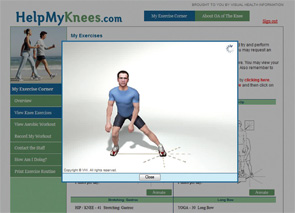
The website being evaluated in the PATH-IN study includes videos that demonstrate proper techniques.
Internet-Based Exercise Program for Knee OA
The Internet-based exercise training program for this study was developed and pilot-tested by Visual Health Information (VHI) Inc., with funds from the National Institutes of Health. VHI is a partner in the PATH-IN study. There are several novel features of this website, which was designed to be a “comprehensive Web-based system to evaluate, prescribe, monitor and adjust therapeutic exercise programs for patients with knee OA.”1 When participants register on this website, they provide information about their pain, function and activity, all of which are used to assign an individualized exercise routine, including stretching, strengthening and aerobic exercises. For example, a participant who begins the program with low function and physical activity may be assigned to a set of exercises in Level 1; this is the easiest level, and many of the strengthening and stretching exercises are completed in a seated or lying position. As participants continue to use the program, they can request more or less challenging exercise programs. As participants progress to higher levels, their exercise routine may contain more difficult exercises, previously assigned exercises with more sets or repetitions and/or an increase in the number of exercises.
For all assigned stretching and strengthening exercises, the website provides videos to demonstrate proper technique (see Figure 1, above). Participants record their exercises on the website, which provides a visual display of their progress over time. To help promote adherence to the physical activity program, the website also sends automated e-mail reminders when participants don’t log onto the website within specified intervals.
A pilot study of this program involved 52 patients with mild to moderate knee OA. Over an eight-week period, there were significant and clinically meaningful improvements in self-reported pain, function, knee self-efficacy and other relevant outcomes among these participants.1 Study participants also reviewed the program positively and used it frequently. Following these promising results, the PATH-IN study is providing an opportunity to further evaluate this website in a rigorous, randomized controlled trial.
Patient-Centered Research Supported by Comprehensive Team
Another exciting aspect of the PATH-IN study is the collaboration among academic research institutions, a company with expertise in rehabilitation/exercise software (VHI), physical therapy clinics, and multiple stakeholders. The physical therapy intervention for PATH-IN is being delivered by multiple clinics serving urban and rural areas of central North Carolina. Physical therapists in these clinics have been key study partners, helping inform the structure of the usual physical therapy intervention so it mirrors routine clinical care, which is important for this pragmatic study. A diverse stakeholder panel is also a key part of this study team, including patients with knee OA (from varying geographic areas served by the study); clinicians with various specialties (e.g., orthopedics, physical therapy, primary care); and representatives of such organizations as the Arthritis Foundation, American Physical Therapy Association, Centers for Disease Control and Prevention, and Department of Veterans Affairs. The perspectives of this group are helping ensure the study is of high relevance to patients and clinicians, and that when complete, it will contribute meaningful evidence about physical activity interventions for knee OA.

